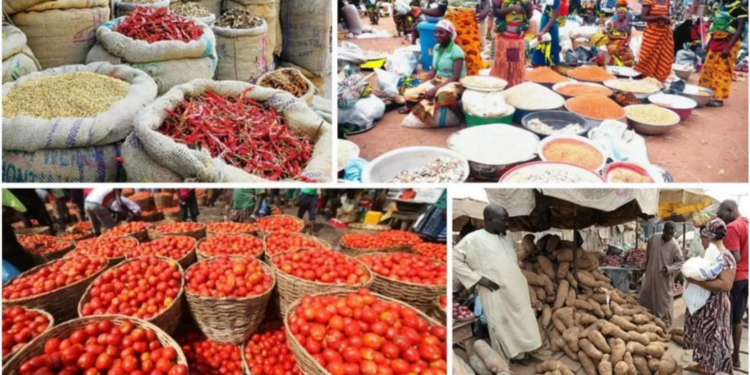Food prices across key markets in Lagos State surged sharply in July 2025, with common household staples such as onions, rice, and pepper leading the price increases. This development has further strained household budgets and intensified the burden of food inflation in Nigeria’s commercial capital. According to the latest
Food Price Survey covering major markets like Mushin, Mile 12, Oyingbo, and Daleko, most food items recorded price hikes, though a few items declined due to seasonal harvests.
Dry onions recorded the most significant price increase in July. A big bag of onions rose by 30% month-on-month from N100,000 in June to N130,000. Traders attributed the steep rise to seasonal scarcity, deteriorating road networks linking northern production areas, rising transportation costs, and higher storage expenses. The shortage has severely affected sellers and buyers alike, with many consumers complaining about the unaffordability of onions, a cooking essential in most Nigerian homes.
Rice, another critical staple, also saw a significant price jump. A 50kg bag of local rice brands like Mama Gold rose by 25%, now selling for N75,000, up from N60,000 the previous month. Traders blamed the increase on the continued depreciation of the naira and high logistics costs affecting both imported and locally processed rice. Consumers have raised concerns about this hike, particularly as rice is a mainstay in many Nigerian households.
Pepper prices also climbed steeply. A big bag of pepper increased by 16.67% to N140,000, while a medium bag rose by 15.38% to N75,000. This upward trend reversed the price declines recorded in the past few months, with traders citing supply constraints and transport bottlenecks as key factors.
Other food items that recorded price increases include frozen fish, with Kote fish prices rising by 10.53% to N4,200 per kg from N3,800, while Titus fish climbed by 7.69% from N6,500 to N7,000. Local palm oil (25 litres) increased by 8.33%, from N60,000 to N65,000, while a 50kg bag of white garri rose by 7.14% to N45,000. Brown beans and Oloyin beans prices also went up moderately, with a 50kg bag of brown beans reaching N90,000 and Oloyin beans N78,000. The cost of refilling a 12.5kg gas cylinder also increased by 5.45%, now averaging N14,500.
Traders expressed worries about thinning profit margins despite the rising prices. Chinedu, a rice wholesaler at Daleko Market, lamented that transport and fuel costs are eroding their profits. He said, “The customer thinks we are enjoying this price hike, but fuel and transport are eating us alive.”
Nevertheless, some food items experienced price drops in July due to improved harvests and stabilizing logistics. Yellow maize (50kg) recorded the steepest price drop, falling by 16.67% from N78,000 to N65,000. Traders attributed this to new harvests from states like Niger, Kaduna, and Plateau. Power Pasta saw a 13.64% decline, now selling at N950 per pack compared to N1,100 in June. Peak Refill Milk (500g/360g) dropped by 12.01% to N4,250.
Yam prices also fell, with a medium tuber of Abuja yam now selling for N4,500, down from N5,000, while a big size tuber dropped by 6.67% to N7,000. Semo (Honeywell, 5kg) declined by 8.06% to N8,550, and Olaola Poundo (2.267kg) fell by 7.41% to N27,000.
Consumers expressed mixed feelings about the price movements. At Oyingbo Market, a trader named Bisi described the price fluctuations as erratic, largely driven by logistics and weather patterns. “The cost of bringing maize from the North has dropped a bit this month, but pepper is another story entirely,” she said.
Mrs. Akinbami, a shopper at Mushin Market, expressed frustration over rice prices. “Rice is a staple in my house, and now it’s increased in price. Every month, it feels like we’re budgeting for luxury, not food,” she said. However, some consumers welcomed the decline in maize and yam prices. Mrs. Ngozi at Oyingbo Market said, “I bought yams cheaper this week, and at least now I can make porridge again.”
The sudden 30% increase in onion prices frustrated many buyers, especially food vendors. Mrs. Kudirat Shobowale at Mile 12 Market said, “Onions are no longer affordable. A single sack is now N130,000, that’s more than my monthly profit. I had to reduce how much I use in my soup. Customers are already complaining about the taste.”
The decline in pasta prices was a small relief for some buyers. Mrs. Juliet Nweke at Mushin Market noted, “I noticed pasta came down this month—N950 is better than N1,100. I bought a few extra packs for my children. It’s still not cheap, but every bit helps.” A student, Mr. Adebayo Hassan, also welcomed the price reduction, saying, “As a student on a tight budget, cheaper pasta makes a difference. It’s my go-to meal.”
However, others like Mrs. Omolola Adeniran at Mile 12 remain skeptical. She warned, “This is how they do—reduce pasta price this month and increase it again next month. I just bought what I could afford and moved on.”
Analysts warn that if these market trends persist in other Nigerian states, food inflation could continue its upward trajectory. According to the National Bureau of Statistics (NBS) June 2025 report, food inflation climbed to 21.97%, up from 21.14% in May, driven by rising prices of key staples like pepper, tomatoes, and plantain flour.
Lagos, in particular, saw food inflation jump by 6.6% in June to 21.7% from 15.1% in May. With key staples continuing to rise in July, more pressure is expected on household incomes and living standards.
The Food Price Watch is a monthly survey that tracks price trends of major food items across Nigeria. The July 2025 report covered Mushin, Daleko, Oyingbo, and Mile 12 markets in Lagos, offering insights for businesses, policymakers, and consumers navigating the country’s volatile food economy.
